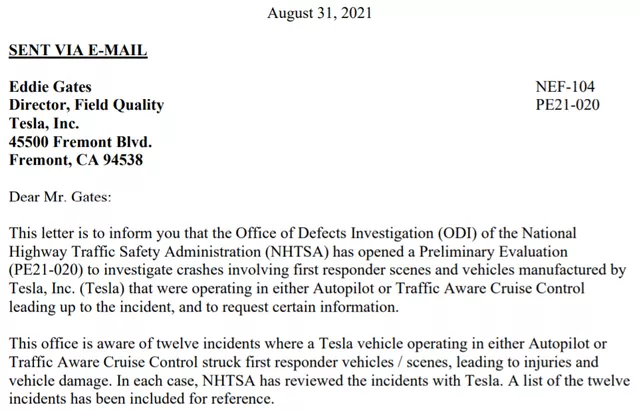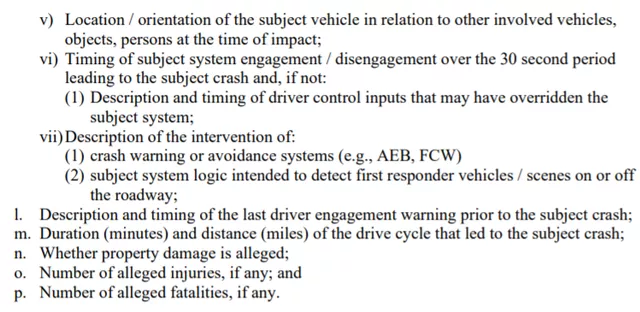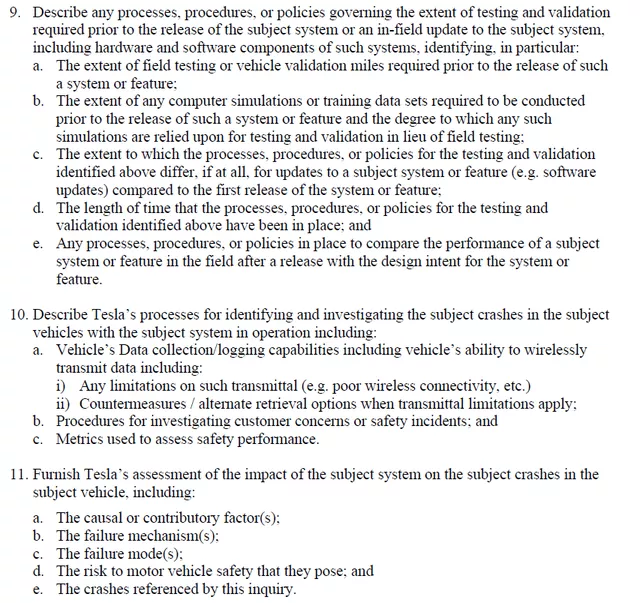With the rapid increase of Tesla’s ownership in the United States, there has been a rise in safety accidents involving the use of Autopilot by Tesla in the United States. In August, the U.S. National Highway Traffic Safety Administration (NHTSA) launched a formal safety investigation into Tesla’s Autopilot driving assistance system, requesting Tesla to provide relevant information and usage data regarding the driving assistance system, as shown in the following figure.

The investigation covers Model Y, X, S, and 3 produced and sold since 2014, including 765,000 vehicles equipped with Autopilot. NHTSA confirmed that these accidents were all caused by the use of Autopilot or TACC. Most of these 12 accidents occurred after dark, and the software ignored on-site warning signs such as warning lights, signal lights, warning cones, and arrow indicator lights, crashing into vehicles emergency parked on the roadside. If NHTSA determines that any vehicle, component, or system has design defects or safety hazards, the agency has the right to issue a mandatory recall. However, before requiring a recall, NHTSA will first conduct in-depth investigations and engineering analyses. The investigation process of these two steps usually takes more than a year.

Information Required by NHTSA
The first part of the information NHTSA requires is mainly related to basic information about the automaker, including VIN, vehicle model, software and hardware versions (underlying), FSD time and mileage, and related time information.

The second part of the information requested includes client complaints, on-site reports, accident reports, third-party processing and litigation, and original information received by the company.


 The main technical details of the vehicle autonomous driving assistant system operation scope are as follows. These details are directly related to the technical content.
The main technical details of the vehicle autonomous driving assistant system operation scope are as follows. These details are directly related to the technical content.



This section of the content is related to Tesla’s verification process. Regarding the relationship between the system and accidents, it is also considered from the mechanism and mode of failure. From the overall process point of view, NHTSA wants to think about obtaining complete failure analysis of the working mechanism of Tesla’s Autopilot system.

Therefore, compared to the investigation in 2017, NHTSA is more serious this time, and due to the number of accidents, there are more data and analysis uploaded.
NHTSA Peer Review
Moreover, the interesting thing is that the National Highway Traffic Safety Administration (NHTSA) sent letters to 12 car manufacturers, requesting these car makers to provide information on the assistive driving systems to assist the agency’s investigation of Tesla’s Autopilot driving assist system. This material is basically identical to the requirements given to Tesla, which means that NHTSA has listed all enterprises related to L2, and used their thinking as a benchmark to measure whether Tesla has any differences from the industry.

BMW and other 12 companies received inquiries from the NHTSA Office of Defects Investigation, requesting the number of vehicles equipped with L2-level driving assist systems sold in the United States, their usage, and the working logic of obstacle recognition and driver attention detection functions. NHTSA’s goal is to analyze and compare the information provided by Tesla and its competitors, obtain differences from the comparison process, and then confirm whether Autopilot has problems as soon as possible.Summary: In my personal opinion, with the increase in production of Tesla, NHTSA has been under great pressure due to the lack of effective regulation on the safety of the Autopilot system. No action was taken in the Autopilot system investigation that ended in 2017. Autopilot can share some driving tasks, allowing the driver to not touch the steering wheel for a long time. However, from the direction of this investigation, NHTSA may restrict the operation mode, location, and time of Autopilot. I believe this investigation is serious and has undergone peer review!
This article is a translation by ChatGPT of a Chinese report from 42HOW. If you have any questions about it, please email bd@42how.com.